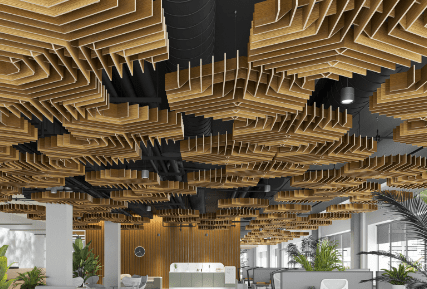
Do you know what a baffle ceiling is? If you’re not familiar with this type of ceiling, don’t worry – you’re not alone. This type of ceiling is actually quite new and not many people are familiar with it. A baffle-ceiling is a type of suspended ceiling that consists of a series of panels that are hung from the main ceiling. These panels are installed in a way that creates a “baffle” effect, which helps to reduce noise levels in the room. If you’re looking for a way to reduce noise levels in your home or office, a baffle-ceiling may be the perfect solution. In this blog post, we will explore everything you need to know about baffle-ceilings, including their benefits and drawbacks.
What is a Baffle Ceiling?
A baffle ceiling, sometimes also called a suspended ceiling, is a type of false ceiling that consists of a grid of metal or wooden beams suspended from the main ceiling. Baffle ceilings are often used in commercial and industrial settings to reduce noise levels and improve acoustics. They can also be used to hide ductwork, wiring, or other unsightly elements.
How Does a Baffle Ceiling Work?
A baffle ceiling is a type of false ceiling that uses acoustic baffles to improve the sound quality in a room. Baffle ceilings are often used in restaurants, offices, and other commercial spaces.
Acoustic baffles are made of absorbent materials that help to reduce reflections and reverberation. They are hung from the ceiling in a grid-like pattern and spaced evenly apart. The spacing and orientation of the acoustic baffles can be customized to achieve the desired sound quality.
Baffle ceilings are an effective way to improve the acoustics in a space without compromising aesthetics. They can be used in conjunction with other sound-absorbing materials such as acoustic panels to create a more comfortable and inviting environment.
The Benefits of a Baffle Ceiling
A baffle ceiling is a type of suspended ceiling that uses a series of horizontal baffles to provide acoustical and visual interest. Baffle ceilings are often used in office spaces, restaurants, and other public areas where there is a need to reduce noise levels.
Baffle ceilings are an effective way to reduce noise levels in a space. The horizontal baffles create a series of partitions that help to break up sound waves and reduce echoes. This can make a space feel more comfortable and quieter.
Baffle ceilings can also be used to create visual interest in a space. The baffles can be made from different materials and colors, and they can be arranged in different patterns. This can add dimension and texture to a room, making it more inviting and interesting.
The Different Types of Baffle Ceilings
There are three main types of baffle ceilings: the standard baffle, the perforated baffle, and the slotted baffle.
Standard Baffle: The most common type of baffle ceiling, the standard baffle is a square or rectangular panel that is suspended from the ceiling by wires. Standard baffles are typically made of acoustical fiberglass or another type of absorbent material.
Perforated Baffle: Perforated baffles are similar to standard baffles, but they have small holes drilled into them. These holes allow sound to pass through the baffle, which means that perforated baffles are less effective at reducing noise than standard baffles.
Slotted Baffle: Slotted baffles are long, thin panels that are suspended from the ceiling by wires. Unlike standard and perforated baffles, slotted baffles do not have any holes drilled into them. This makes them more effective at reducing noise than both types of baffling ceilings.
How to Install a Baffle Ceiling
Baffle ceilings are a type of suspended ceiling that consists of a grid system of metal channels suspended from the ceiling joists. Baffle ceilings are typically used in commercial spaces, but can also be used in residential settings.
Installing a baffle ceiling is not a difficult task, but there are a few things you will need to know before you get started. First, you will need to purchase the necessary materials and tools. Second, you will need to determine the size and layout of your baffle ceiling. And third, you will need to follow the instructions carefully in order to avoid any mistakes.
Here is what you will need in order to install a baffle ceiling:
-Metal channels (these can be purchased at most hardware stores)
-Ceiling grid system (this can also be purchased at most hardware stores)
-Wire cutters
-Tape measure
- level
- drill
- screws
- drywall anchors
- hammer
The first thing you need to do is purchase the necessary materials and tools. You can find all of these items at most hardware stores. Once you have gathered everything together, take a moment to familiarize yourself with the parts and pieces.
Next, use a tape measure to determine the size and layout of your baffle ceiling. It is important to take accurate measurements so that your ceilings will fit perfectly. Use a level to make sure that your lines are straight before proceeding to the next step.
Now it is time to start installing your baffle ceiling. Begin by attaching the metal channels to the ceiling joists using screws and drywall anchors. Make sure that the channels are level before moving on.
Next, attach the ceiling grid system to the metal channels. Again, use screws and drywall anchors to secure the grid in place. Once the grid is installed, you can begin adding the baffles.
Cut the baffles to size using wire cutters and then insert them into the grid system. Make sure that the baffles are level before moving on to the next one. Repeat this process until all of the baffles are in place.
Now it is time to install the ceiling tiles. Cut the tiles to size using a utility knife and then insert them into the grid system. Make sure that they are level and evenly spaced before moving on to the next row. Repeat this process until all of the tiles are in place.
Baffle-Ceiling Recipes
Baffle ceilings are a great way to add interest and dimension to any room, and they’re surprisingly easy to create! Here are a few recipes to get you started:
- Start with a basic square or rectangular grid. To add interest, try using different sizes and shapes of baffles.
- Create an asymmetrical design by offsetting the baffles in the grid.
- Go for a more organic look by randomly placing the baffles in the grid.
- For a modern twist, use clean lines and sharp angles in your design.
- Use color to create visual interest and contrast.
- Add texture by using different materials for the baffles, such as wood, metal, or fabric.
Alternatives to the Baffle-Ceiling
If you’re looking for an alternative to the baffle-ceiling, there are a few options available. One option is the drop ceiling, which is similar in design but uses panels instead of baffles. Another option is the suspended ceiling, which hangs from the ceiling joists and doesn’t require any special installation. Finally, you could simply paint your ceiling or apply wall stickers to create a unique look.
Conclusion
A baffle-ceiling can be a great addition to any home, providing both style and function. If you’re thinking about installing a baffle-ceiling in your own home, be sure to do your research and figure out what type of ceiling would suit your needs best. With so many options on the market, there’s sure to be a baffle-ceiling that’s perfect for you. Thanks for reading!



